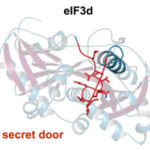On July 28, Biosciences Principal Deputy Mary Maxon moderated a panel of National Lab and industry speakers who discussed “Advanced Biosciences for Manufacturing: Driving Solutions in Energy, Health and the Environment.” The Capitol Hill event was sponsored by the American Society of Mechanical Engineers in conjunction with the U.S. Council on Competitiveness and the House of Representatives Manufacturing Caucus. Over 100 congressional staffers attended the briefing and asked a broad variety of questions, including those focused on what Congress could do to drive biomanufacturing in the U.S. The program and panel presentations (part 1 and part 2) are posted on the House Manufacturing Caucus website, along with information about other caucus events.
Study Finds Molecular Switch That Triggers Bacterial Pathogenicity
Scientists have revealed that the supercoiling of bacterial chromosomes around histone-like proteins can trigger the expression of genes that make the microbe invasive. The discovery could provide a new target for the development of drugs to prevent or treat bacterial infection.
The study lead author Michal Hammel, research scientist in the Molecular Biophysics & Integrated Bioimaging (MBIB) Division, teamed up with MBIB faculty scientist Carolyn Larabell; both are pictured above. Read more on the Berkeley Lab News Center.
When Targeting Cancer Genes, Zero in on the One Percent
UC Berkeley researchers have found a promising new drug target within the pathway that controls production of a cell’s thousands of proteins. That is appealing, in part, because it appears to control production of only a few percent of the body’s many proteins, those critical to regulating the growth and proliferation of cells. The study was led by Jamie Cate, a faculty scientist in Berkeley Lab’s Molecular Biophysics & Integrated Bioimaging Division. Read more on UC Berkeley News.
New Technologies Fuel Cryo-EM’s Renaissance
In a pair of breakthrough Nature papers published recently, researchers in Eva Nogales’ Lab at UC Berkeley and Berkeley Lab (Molecular Biophysics & Integrated Bioimaging Division) mapped two important protein functions in unprecedented detail: the role of TFIID, effectively improving our understanding of how our molecular machinery identifies the right DNA to copy; and how proteins unzip double-stranded DNA, which gives us insights into the first-key steps in gene activation.
These papers are representative of the renaissance currently under way in the cryo-electron microscopy (cryo-EM) field—driven primarily by the rise of cutting-edge electron detector cameras, sophisticated image processing software and access to NERSC supercomputing resources. Read the full story, written by Linda Vu of NERSC.
Downing Recognized with MSA Distinguished Scientist Award
Ken Downing, biophysicist senior scientist in the Molecular Biophysics & Integrated Bioimaging Division, has been honored as the recipient of the 2016 MSA Distinguished Scientist Award in the Biological Sciences. With the Distinguished Scientist Awards, the Microscopy Society of America (MSA) annually recognizes a preeminent senior scientist from each of the Biological and Physical Sciences who has a long-standing record of achievement during his or her career in the field of microscopy or microanalysis. Downing will be presented with the award at the Plenary Session of the Microscopy & Microanalysis 2016 Meeting on July 26, in Columbus, Ohio.
In 2010, Downing was elected MSA Fellow and recognized as a senior distinguished member of the society who has made significant contributions to the advancement of the field of microscopy through a combination of scientific achievement and service to the scientific community and the society itself.
- « Previous Page
- 1
- …
- 7
- 8
- 9
- 10
- 11
- Next Page »
Was this page useful?








